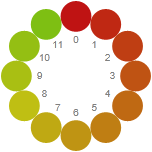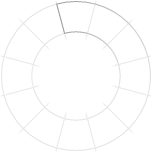

Your mileage may vary, but I would say that it takes not much more time and patience to learn the elements of music than it does to learn, for example, how chess pieces move. Each musical concept is simple on its own, but together they interact in rich and complex patterns. That's why—like chess—the relatively easy-to-grasp elements of music can take a lifetime to fully explore, appreciate, and master.
This section is about those elements. First, you'll hear how the twelve tones are named to make notes. Then how scales are chosen from those notes. Scales will reveal intervals, and intervals will be stacked into chords. Music has an alphabet and an arithmetic that are different from the ones you already know. So don't worry if takes time and practice to become fluent in them.
The pages of this section are primarily intended to be a reference to complement and support (not replace) a course of teaching. Consequently, I introduce the concepts here in a slightly different sequence than I would in a personal course of teaching. When teaching, the learning curve is more comfortable when the particular is introduced before the general. But to do that here would not be the best use of space and so, in places, the general (for example, the major scale formula) comes before the particular (the C major scale, to continue the example). The content in these pages is compact and definitive only because it is tuned to function as a reference and a refresher. Even so, if you're a sufficiently motivated autodidact then you'll be successful using the material in these pages as your first—and only—learning resource. And you'll find that it's suitable for any level of experience: even if you have to read through it more than once. If you're an absolute beginner, you'll find that no prior knowledge of music is needed. If you've already studied music, then this content aligns with how you've internalized the concepts; but you're sure to find something new and fresh, too.
A note about Microsoft Silverlight. Some of the interactive content in the page below uses Microsoft Silverlight, which works in Internet Explorer, and some other browsers, but it doesn't work in 100% of browsers. If you don't have Silverlight installed then you'll see an install badge in place of the content.![]()
If your browser doesn't support Silverlight then the install badge will remain even after you've gone through the install process. In that case, if you really want to see the Silverlight content on this page, then you can install Internet Explorer (or another compatible browser), or click here to see static screenshots of the interactive content opened in a new browser tab. But, in any case, this is the only page on my site where I use Silverlight, and none of the interactive content below is vital, so don't worry if you miss it (the vital material begins on the next page, Notes and major scales).
In this segment we'll look at the important relationship between notes that are an octave apart.
Musical tones reach the ear in the form of waves of air pressure, and you can imagine a vibrating string moving back and forth in the air and sending out these waves at a particular frequency. The lowest-pitched tones we can hear are made by waves at a frequency of about 20 per second (20 Hz, pronounced hertz). The highest-pitched we can hear have a frequency of about 20 000 waves per second (20 kHz, pronounced kilohertz). Interestingly, for us to perceive linear increases in pitch, frequency has to increase exponentially. This is the reason why frequency ratios are essential to music, and not frequency differences.
Tones with frequencies that are not related sound odd together, or even unpleasant. But tones whose frequencies are related by simple ratios sound good together. They sound musical. The simplest frequency ratio is 1:2 and it is the ratio between a tone and the tone an octave higher. In other words, an octave is the interval between any frequency f and the frequency 2f, where the waves are coming at exactly twice the rate. In the illustration below you can audition three notes whose frequencies successively double to make each sound one octave higher than the last. Hover over the '?' button for more info.
There's actually more to the structure of a musical tone than the simple sine wave implied by the illustration. A tone vibrates at its characteristic fundamental frequency and also, more softly, at harmonic frequencies that are integer multiples of the fundamental. This is the harmonic series. Some harmonics fall at octaves above the fundamental, the others fall in the space between and they round out the octaves with new tones. Interestingly then, it's from the harmonic series of a single tone that we get the twelve tones of the octave. These are the twelve tones to which musical instruments are tuned and from which Western music is made.
Here is the same frequency spectrum shown above, except this time it has been coiled into a 3D helix of repeating octaves where each octave is a clock of twelve discrete tones. You can click (or touch) and drag on the tone helix to view it from different angles.
Click (or tap) Reveal the tone clock in the illustration above to view the helix from just the right angle to see all the octaves stacked up one behind the other. From this perspective we can see only the frontmost octave in the tone helix. But one octave is much the same as any another so, from here on, we'll focus our study on this one slice taken from the helix: a loop of twelve consecutive tones arranged like the dial of a clock. A tone clock.
If you like, click (or tap) Return to the tone helix to view the 3D helix again.

For the purposes of writing music, there are only twelve tones. Each tone has equivalents, a multiple of twelve steps away in every higher and lower octave, and these equivalents have the same name and the same musical function. So if you understand just these twelve tones and their interplay then you understand all of music. The tone clock illustrates a scale called the chromatic scale. The number beside each tone indicates how many clockwise steps a tone is from the beginning of the scale. As you can see, twelve steps away takes you to the equivalent tone in the next octave.
Before we move on, let's take a quick sneak preview of scales (which are described in full detail on the Notes and major scales and Minor scales pages).
Here is the tone clock again: this time in the form of a blank canvas on which we can sketch out a scale.

The twelve tones of the tone clock are the tones with which songs are written. You don't use all twelve tones in one song (except in very unusual cases). And that's because a tune is based on the notes in a scale. You create a scale by choosing just seven of the twelve tones and promoting those seven tones to important roles as the degrees of the scale. Scale degrees are the sounds that perform the most important functions in a tune, and they're the sounds used most often in it.
In the interactive demo below, you can select which of three scales to show in the tone clock (the major scale, the natural minor scale, or the harmonic minor scale). If you choose a minor scale then the major scale is also shown (in the center of the tone clock) so that you can see how the degrees of the minor scales differ relative to the major scale.
Click (or tap) the play button to audition the selected scale. The stop button stops auditioning. The tone clock and the keyboard are synchronized so you can click or tap either one to play tones. When the little power button (above the keyboard) is on, you can also use your computer keyboard to play tones and chords.
Hover over either of the '?' buttons for more info.